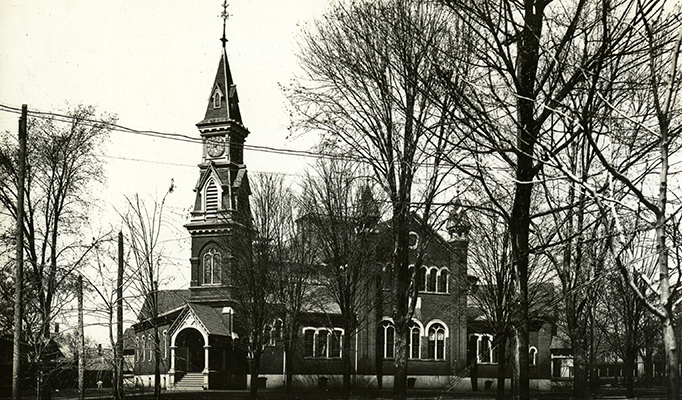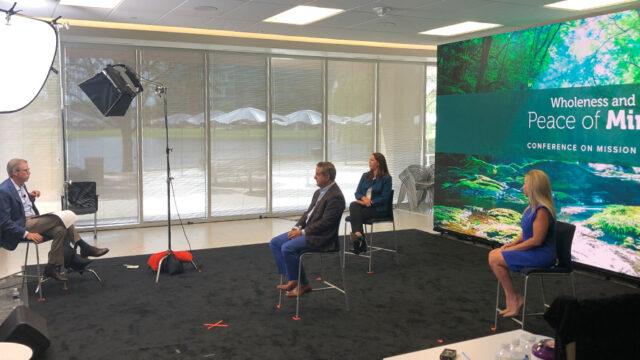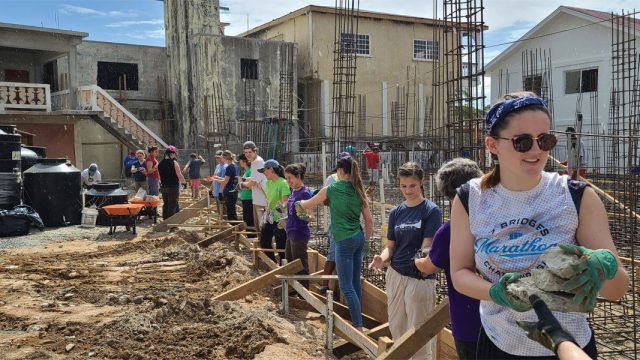Building to God’s glory

We are running a series on the Battle Creek Historic Village in Battle Creek, Michigan, on our ARTV channel. This week, watch the 7-minute video by Adventist historian Jim Nix on the five churches that were built in Battle Creek. To open your eyes to more on church architecture, we also are featuring this article from the September 15, 1988, Adventist Review. We hope you enjoy both the article and the video. You can view the video by clicking this link: https://www.artvnow.com/videos/meetinghouse—Editors.
In the winter of 1978, I visited Finland. Late afternoon I made my way by public transport to the university campus, set in a forest just outside Helsinki. It was quite dark as I carried my suitcase to a dormitory at the highest part of the site. Sleep came easily to a weary traveler.
The next thing I knew, the sun was shining through the window, and I heard distant, repetitive sounds of hammers driving nails into wood. I arose and soon made my way to the ground-floor exit. As I rounded the corner of the dormitory I could scarcely believe my eyes. The Otaniemi Chapel, which I had visited during the 1960s, was again being built.
I walked up the slope as if transfigured in time. In 1957, two architects—a husband and wife—won a design competition for a building of outstanding simplicity. The Otaniemi Chapel served the community for 20 years. Then one morning the pastor telephoned the architects’ office. “You know the building you designed 20 years ago? It burned down last night. Get out the plans. We want to build it again. No changes.”
Think of the options available to the client: Hire another architect, initiate the right process, achieve a building appropriate to the 1980s, refine the building to fit the program more closely, or modify the original in some other way. But no. The client decided to build the original again.
Timeless Quality
On that winter’s morning I thought of appropriateness, of an architecture that could respond to timeless qualities, and of a creative endowment that would lead an architect to respond with sensitivity and accountability to a design situation.
The architect’s words at the dedication of the Otaniemi Chapel in 1957 proved significant. “Without wishing to claim that the Otaniemi Chapel is old-fashioned,” said Heikki Siren, “we can perhaps indicate certain basic features that link it with the traditions of old Finnish buildings.” There is a timeless quality.
In 1979, while these architects oversaw construction of the second Otaniemi Chapel, a California architect was writing The Timeless Way of Building. In this third of a trio of books, Christopher Alexander introduces and discards words that might assist in defining “a quality without a name.” He shares his inner experiences, at one point describing a visit to a Japanese village where a farmer had made a simple fishpond.
“The pond was a simple rectangle, about six feet wide, and eight feet long, opening off a little irrigation stream. At one end a bush of flowers hung over the water. At the other end, under the water, was a circle of wood, its top perhaps 12 inches below the surface of the water. In the pond there were eight great ancient carp, each maybe 18 inches long, orange, gold, purple, and black: the oldest one had been there 80 years. The eight fish swam, slowly, slowly, in circles—often within the wooden circle. The whole world was in that pond. Every day the farmer sat by it for a few minutes. I was there only one day, and I sat by it all afternoon. Even now, I cannot think of it without tears. Those ancient fish had been swimming, slowly, in that pond for 80 years. It was so true to the nature of the fish, and flowers, and the water, and the farmers, that it had sustained itself for all that time, endlessly repeating, always different.”1
My life has been enriched by visits to several church buildings that share with me a timeless quality. An example is Temppeliaukio in Helsinki, where a worship space has been cut from a rock outcrop. For generations the acropolis site has been surrounded by apartment houses. The church building, completed in 1969, preserves the openness of the setting and continues opportunities for public access onto the outcrop. A small metal cross is bolted to the rock near the church entrance.
The experience inside combines a sense of security within a space subtracted from the bedrock and a sense of unification under a shallow, domed ceiling. Inclined areas of roof glazing add just the irregularities of the rock walls to the exact geometry of the dome. Imagine the qualities of this worship space when candles flicker on the natural rock shelves, the thin copper ceiling strips reflect all available light, and music fills the reverberant space.
Creation and Coming
We may ask, “Should we set out to provide an architecture for the Seventh-day Adventist Church that aspires to a timeless quality?” I believe the answer lies in a design process that is Creator-oriented.
Harold M. Best, in his essay “God’s Creation and Human Creativity,” suggests that contemporary humankind creates a division between worth and function.
“If a thing is intended to be used up quickly, it is not likely to be as carefully made as something intended to ‘last.’ In God’s economy, the creation does not suffer from the values of the throw-away. God thinks and works differently. Roses wither and die, living things perish quickly, an apple that takes months to grow is eaten in a trice. Richly grained wood is burned in the fire; fire itself, in all of its beauty, is but an instant. Even though God’s handiwork is used up, some more quickly than the rest, every speck of it is carefully and lovingly made. The rose, the earthworm, the mosquito, and the cabbage leaf are as lovingly constructed, richly variegated, and profoundly fascinating as a galaxy. There is no division of purpose. There are no two qualities of workmanship, one for the instant, the other for the ages. Being quickly used does not justify being sloppily made. The integrity of the Maker never changes with the transiency of the creature. There is no model whatsoever in the Creation for a division between worth and function, or immediacy and timelessness.”2
The design quality of Shaker furniture is recognized for the conceptual thinking that occurred in the design process and the high standard of workmanship during construction. Recently, I attended a lecture by Adventist architect Llewellyn Seibold. With a major excursion into Shaker buildings and furniture, he challenged the audience to design with sensitivity and build as craftsmen. His lecture, “An Angel’s Chair,” responded to the question “What is the nature of a chair you could offer to your guardian angel?”
There is a timeless creativity the Creator may bestow to beings created in God’s image and “endowed with a power akin to that of the Creator—individuality, power to think and to do.”3
An alternative to a timeless building is a building unique to a particular time. This is especially important to Seventh-day Adventists, for it is natural that planning for buildings would occur within the uniqueness of a present-day message. For people living on the edge of the Second Advent, sustaining the sense of immediacy becomes a real concern. The eschatological viewpoint, however, has often focused on the journey’s end, with little acceptance of how the creative process and aesthetics can enrich the journey. Adventist architect Robert Burman has accurately characterized some churches as railroad carriages.
Are we to focus on destination, to the exclusion of artistic expressions of the individual or culture? Many early Adventist churches were highly appropriate to time and place. To continue to repeat the form of these buildings may indicate, however, that we lack depth of thought, resulting in a railroad-carriage focus on destination, without thought of enriching the journey. I believe we must balance our focus on the destination of the Second Coming, with participation of every individual in a cooperative, creative process, continuing the one God initiated with humankind in Eden.
Why Enrich?
My strongest childhood memories of a worship experience picture wooden benches in a natural setting. Beyond the “green cathedrals” of our youth camps, why should we seek environments that speak to spirituality and the human soul? Why enrich when enrichment costs money? Why should any or all of the buildings of the church organization, its work environments, and our homes use limited dollars to enrich the journey when time is short and other places may be experiencing an urgency for action? Why an architecture of enrichment?
We enrich our lives for the health and wholeness of the individual and the group. Mabel Bartlett, Adventist art historian, defines aesthetics in terms of adding to the compass of one’s life. The aesthetic experience augments our wholeness as it adds to the compass of our lives. We care about architectural design to understand better the Creator, who was poet and carpenter. Extending the value of our participation in design, we make environments and spaces appropriate in both practicality and meaning. This begins to suggest a responsive architecture—buildings and spaces that address the needs of physical, intellectual, and spiritual humankind.
Seven Areas
Whenever client and architect begin to work together on an architecture for and about Christians, at least seven areas need to be considered. Our buildings should respond uniquely to the environment, human activities, climate, cost, society, culture, and symbolism.
Environment. A first, concern in the design process is for a perceptive approach toward the environment. In terms of designing with nature, our church buildings should provide the clearest statement on environmental stewardship. Perhaps you recall a church building set in a garden. One I have enjoyed is the Pfingstberg church in Mannheim, Germany. A pedestrian approach leads past the bell tower and rises to a gathering place that is experienced as an “outdoor room.” Above the entrance doors one can see a reflection of the belltower. Even from this outside perspective one can perceive the structural ceiling members as counterparts to the branches and leaf veins of the surrounding trees.
The environment context is equally important in a city setting. Urban Christian churches ought to be designed as “good neighbors” to surrounding buildings, yet at the same time set apart. The building of the Citicorp project in Manhattan necessitated replacement of a church building. St. Peter’s Lutheran Church holds its own amid the high-rise developments. It is in scale with a gathering space where people may stop, communicate, rest, and eat in the outdoors. From the street, the passerby can see into a worship space. The church is in the world and for the world, but it preserves its integrity. A change in geometric form sets it apart from the towering rectilinear buildings for banking and commerce.
Human activities. Buildings provide spatial enclosure for human activities. The Emmanuels church in Jonkoping, Sweden, is a replacement building in a historic area of timber buildings. The limited site and a large program of community needs precluded a generous entry courtyard, so architects designed a small octagonal space next to the street, entered beneath a cantilevered portal. It welcomes passersby to enter anytime during the long hours the building is open. Seats near the separate entrances to the church and social center focus on a central tree. The emphasis on human needs and preferences continues into the foyer, where one first sees a table with provisions for hot and cold drinks. People naturally respond by placing a few kronor on the counter, taking up a cup and pastry, and moving to a nearby chair.
Christopher Alexander, in his book A Pattern Language, asks, “Have you ever walked into a public building and been processed by the receptionist as if you were a package? To make a person feel at ease, you must do the same for him as you would do to welcome him to your home.”4 As Christians, we recognize our greater responsibility.
Climate. A third area for design consideration is climate. In the housing development at Landskronar, Sweden, the private courtyards have sliding-wall enclosures so users can optimize sunlight penetration or protect from cold wind. The door from the courtyard to the house is divided into two sections so the upper section can be opened as a window, again offering options for climate control and privacy.
Cost. Central to the design of appropriate environments is the aspect of cost. Even a building with a large budget must convey a message of accountability. Fortunately, design quality does not depend on large budgets. The low-cost Dernbach church, West Germany, presents a simplicity in plan and section, and the materials are standardized, off-the-shelf components. The church design emphasizes a luxury of planting.
Society. Concerns for individual and community needs, and a cost-accountable architecture, lead us to consider environment design for the wholeness of society. Not only must we attend to all matters of structural safety, nontoxic materials, and barrier-free design, but the Christian must extend every effort for society’s health and happiness. In many ways, Christians follow the physician’s diagnostic role, perceiving areas of stress and relieving tensions in activity settings.
More than 30 years ago, Scandinavian architect Alvar Aalto wrote, “There are many situations in life in which the organization is too brutal; it is the task of the architect to give life a gentler structure.”5 A local government building by this architect serves to illustrate. One side of the Saynatsalo town hall has a ceremonial entrance. On the other side, facing toward the local community, is an entrance of human scale, with stairs of grass and wood, leading to a wonderful courtyard, where the community can gather. Local users have easily learned to identify with the government offices and town hall.
Culture. Building design should also respond to culture. The geographic, historic, and societal contexts may combine into a spirit of place, or genius loci. Architectural forms of the Vols church in Austria are appropriate to the mountain setting. The Arizona Conference Center, near Phoenix, harmonizes with the forms and colors of the desert landscape. The philosophy of Frank Lloyd Wright has continued in the work of Taliesen Associated Architects, who designed the center. Adventist interior designer Jeanne Bengtsson brought together the writings of Wright with statements of Ellen White that speak of nature and creativity. The resulting building fits well into the cultural and landscape environment of the southwestern United States.
Symbolism. The architectural design process must include a consideration of symbolism. Art and architectural history provide a vocabulary of symbolic forms and spaces. Designers of contemporary church spaces will want to respond to this and to Christian church history in selecting symbols to convey meaning. In the design of the Hillview church in Australia, we included a “towel of humility” and symbols of the Communion meal as important elements at the front of the church. The congregation prepared the white woolen wall hanging, and one member handcrafted the pottery platter and cups.
The Canberra National Church in Australia integrates water as an important symbol. A courtyard separates the earlier church building, now a multipurpose hall, from the new church. The triangular buttresses of the new church rise from a large pool within the courtyard. Worshipers enter the church building at a level beneath the waterline. Reflected sunlight from the water’s surface adds a subdued play of light onto a rising plane of the white plaster ceiling. To one side of the pulpit, a cylindrical baptismal font bathed in light emphasizes the significance of baptism.
Sacred Space
The one-family house is an expression of human and cultural values. In some societies, marriage is directly associated with the building of a house. The space the lovers jointly produce is their home. A contemporary architectural philosopher, Christian Norberg-Schulz, continues the thought with this statement: “When space of love becomes public . . . it gains the character of a sacred space.”6 The concept of dwelling includes “an imageable structure that offers rich possibilities for identification.” Human beings dwell when they experience the environment as meaningful. “The task of the architect is to create meaningful places whereby he helps man to dwell.”
In addition, Seventh-day Adventists may find profound implications in these words of Dutch architect Aldo Van Eyck: “Architecture can do no more, and must not do less, than assist one’s homecoming.”
REFERENCES
1 Christopher Alexander, The Timeless Way of Building (New York: Oxford University Press, 1979), p. 38.
2 Harold M. Best, “God’s Creation and Human Creativity,” in Harold Heie and David L. Wolfe, ed., The Reality of Christian Learning: Strategies for Faith-Discipline Integration (St. Paul: Christian University Press), p. 263.
3 Ellen G. White, Education (Mountain View, Calif.: Pacific Press Pub. Assn., 1903), p. 17.
4 Christopher Alexander, A Pattern Language (New York: Oxford University Press, 1977), p. 705.
5 Aarno Ruusuverosi, ed., Alvar Aalto (Helsinki: Museum of Finnish Architecture, 1978), p. 50.
6 Christian Norberg-Schulz, Existence, Space and Architecture (London: Studio Vista, 1971), p. 114.








